Design and Fabrication of Tryptophan Sensor Using Voltammetric Method
Abstract
:1. Introduction
2. Experimental Section
2.1. Chemicals
2.2. Synthesis of Ni-WO3
2.3. Instrumental
2.4. Electrode Modification
3. Results and Discussion
3.1. Materials Characterization
3.2. ElectroCatalytic Properties of WO/GC and NWO/GC
3.3. Electrochemical Sensing Performance of WO/GC and NWO/GC
4. Conclusions
Supplementary Materials
Author Contributions
Funding
Data Availability Statement
Acknowledgments
Conflicts of Interest
References
- Kochen, W.; Steinhart, H. (Eds.) L-Tryptophan: Current Prospects in Medicine and Drug Safety; Walter de Gruyter: Berlin, Germany, 1994. [Google Scholar]
- Naganathan, D.; Thangamani, P.; Selvam, T.; Narayanasami, T. Ce doped ZnO/f-MWCNT moss ball like nanocomposite: A strategy for high responsive current detection of L-tryptophan. Microchim. Acta 2018, 185, 96. [Google Scholar] [CrossRef]
- Yokus, O.A.; Kardas, F.; Akyıldırım, O.; Eren, T.; Atar, N.; Yola, M.L. Sensitive voltammetric sensor based on polyoxometalate/reduced graphene oxide nanomaterial: Application to the simultaneous determination of l-tyrosine and ltryptophan. Sens. Actuator B Chem. 2016, 233, 47–54. [Google Scholar] [CrossRef]
- Peng, Z.; Jiang, Z.; Huang, X.; Li, Y. A novel electrochemical sensor of tryptophan based on silver nanoparticles/metal–organic framework composite modified glassy carbon electrode. RSC Adv. 2016, 6, 13742–13748. [Google Scholar] [CrossRef]
- Li, J.; Kuang, D.; Feng, Y.; Zhang, F.; Xu, Z.; Liu, M.; Wang, D. Green synthesis of silver nanoparticles–graphene oxide nanocomposite and its application in electrochemical sensing oftryptophan. Biosens. Bioelectron. 2013, 42, 198–206. [Google Scholar] [CrossRef]
- Prabhu, P.; Babu, R.S.; Narayanan, S.S. Electrocatalytic oxidation of L-tryptophan using copper hexacyanoferrate film modified gold nanoparticle graphite-wax electrode. Colloids Surf. B 2011, 87, 103–108. [Google Scholar] [CrossRef] [PubMed]
- Chen, J.; He, P.; Bai, H.; He, S.; Zhang, T.; Zhang, X.; Dong, F. Poly(β-cyclodextrin)/carbon quantum dots modified glassy carbon electrode: Preparation, characterization and simultaneous electrochemical determination of dopamine, uric acid and tryptophan. Sens. Actuators B 2017, 252, 9–16. [Google Scholar] [CrossRef]
- Frith, K.-A.; Limson, J.L. pH tuning of Nafion® for selective detection of tryptophan. Electrochim. Acta 2009, 54, 3600–3605. [Google Scholar] [CrossRef]
- Lian, W.; Ma, D.J.; Xu, X.; Chen, Y.; Wu, Y.L. Rapid high-performance liquid chromatography method for determination of tryptophan in gastric juice. J. Digest. Diseas. 2012, 13, 100–106. [Google Scholar] [CrossRef]
- Hosseini, M.; Ganjali, M.R.; Vaezi, Z.; Arabsorkhi, B.; Dadmehr, M.; Faridbod, F.; Norouzi, P. Selective recognition histidine and tryptophan by enhanced chemiluminescence ZnSe quantum dots. Sens. Actuators B 2015, 210, 349–354. [Google Scholar] [CrossRef]
- Zhang, Y.; Yao, W.; Liang, D.; Sun, M.; Wang, S.; Huang, D. Selective detection and quantification of tryptophan and cysteine with pyrenedione as a turn-on fluorescent probe. Sens. Actuators B 2018, 259, 768–774. [Google Scholar] [CrossRef]
- Arroquia, A.; Acosta, I.; Armada, M.P.G. Self-assembled gold decorated polydopamine nanospheres as electrochemical sensor for simultaneous determination of ascorbic acid, dopamine, uric acid and tryptophan, Mater. Sci. Eng. C 2020, 109, 110602. [Google Scholar] [CrossRef] [PubMed]
- Yola, M.L.; Atar, N. Functionalized graphene quantum dots with Bi-metallic nanoparticles composite: Sensor application for simultaneous determination of ascorbic acid, dopamine, uric acid and tryptophan. J. Electrochem. Soc. 2016, 163, B718–B725. [Google Scholar] [CrossRef]
- Zeinali, H.; Bagheri, H.; Monsef-Khoshhesab, Z.; Khoshsafar, H.; Hajian, A. Nanomolar simultaneous determination of tryptophan and melatonin by a new ionic liquid carbon paste electrode modified with SnO2-Co3O4@rGO nanocomposite. Mater. Sci. Eng. C 2017, 71, 386–394. [Google Scholar] [CrossRef] [PubMed]
- Nie, X.; Zhang, R.; Tang, Z.; Wang, H.; Deng, P.; Tang, Y. Sensitive and selective determination of tryptophan using a glassy carbon electrode modified with nano-CeO2/reduced graphene oxide composite. Microchem. J. 2020, 159, 105367. [Google Scholar] [CrossRef]
- Yang, H.; Cao, G.; Huang, Y.; Lin, Y.; Zheng, F.; Lin, L.; Liu, F.; Li, S. Nitrogen-doped Carbon@TiO2 double-shelled hollow spheres as electrochemical sensor for simultaneous determination of dopamine and paracetamol in human serum and saliva. J. Pharmaceut. Anal. 2021, 12, 436–445. [Google Scholar] [CrossRef]
- Haldorai, Y.; Yeon, S.-H.; Huh, Y.S.; Han, Y.-K. Electrochemical determination of tryptophan using a glassy carbon electrode modified with flower-like structured nanocomposite consisting of reduced graphene oxide and SnO2. Sens. Actuator B Chem. 2017, 239, 1221–1230. [Google Scholar] [CrossRef]
- Sun, D.-F.; Li, H.-J.; Li, M.-J.; Li, C.-P.; Dai, H.-L.; Sun, D.-Z.; Yang, B.-H. Electrodeposition synthesis of a NiO/CNT/PEDOT composite for simultaneous detection of dopamine, serotonin, and tryptophan. Sens. Actuator B Chem. 2018, 259, 433–442. [Google Scholar] [CrossRef]
- Khan, M.Q.; Alharthi, F.A.; Ahmad, K.; Kim, H. Hydrothermal synthesis of BaTiO3 perovskite for H2O2 sensing. Chem. Phys. Lett. 2022, 805, 139950. [Google Scholar] [CrossRef]
- Khan, M.Q.; Kumar, P.; Khan, R.A.; Ahmad, K.; Kim, H. Fabrication of Sulfur-Doped Reduced Graphene Oxide Modified Glassy Carbon Electrode (S@rGO/GCE) Based Acetaminophen Sensor. Inorganics 2022, 10, 218. [Google Scholar] [CrossRef]
- Ahmad, K.; Raza, W.; Alsulmi, A.; Kim, H. Design and fabrication of MnO2@ZIF-8 composite for electrochemical sensing of environment pollutant hydrogen peroxide. Colloids Surf. A Physicochem. Eng. Asp. 2023, 674, 131937. [Google Scholar] [CrossRef]
- Ahmad, K.; Kim, H. Hydrothermally grown MoS2-flowers as low cost counter electrode material for dye sensitized solar cell and electrode modifier for electrochemical sensing of 4-chlorophenol. Mater. Sci. Eng. B 2023, 295, 116563. [Google Scholar] [CrossRef]
- Niyitanga, T.; Ahmad, K.; Chaudhary, A.; Kim, H. Carbon dots as efficient electrode material for hydrogen peroxide sensing applications: A mini review. Inorg. Chem. Commun. 2023, 156, 111249. [Google Scholar] [CrossRef]
- Ahmad, K.; Kim, H. MoSe2-nanoflowers as bi-functional electro-catalyst: An efficient counter electrode material for dye-sensitized solar cells and electrode modifier for hydrazine sensor. Mater. Chem. Phys. 2023, 296, 127260. [Google Scholar] [CrossRef]
- Khan, M.Q.; Khan, R.A.; Ahmad, K.; Kim, H. Fabrication of a ZnO Hexagonal Plates/rGO Composite for Application in Nitrite Sensing and Photocatalytic Hydrogen Production. ChemistrySelect 2022, 7, e202203160. [Google Scholar] [CrossRef]
- Li, B.; Xie, X.; Meng, T.; Guo, X.; Li, Q.; Yang, Y.; Jin, H.; Jin, C.; Meng, X.; Pang, H. Recent advance of nanomaterials modified electrochemical sensors in the detection of heavy metal ions in food and water. Food Chem. 2024, 440, 138213. [Google Scholar] [CrossRef]
- GunaVathana, S.D.; Wilson, J.; Prashanthi, R.; Peter, A.C. CuO nanoflakes anchored polythiophene nanocomposite: Voltammetric detection of L-Tryptophan. Inorg. Chem. Commun. 2021, 124, 108398. [Google Scholar] [CrossRef]
- Gao, J.; Li, H.; Li, M.; Wang, G.; Long, Y.; Li, P.; Li, C.; Yang, B. Polydopamine/graphene/MnO2 composite-based electrochemical sensor for in situ determination of free tryptophan in plants. Anal. Chim. Acta 2021, 1145, 103–113. [Google Scholar] [CrossRef]
- Fan, Y.; Liu, J.H.; Lu, H.T.; Zhang, Q. Electrochemistry and voltammetric determination of L-tryptophan and L-tyrosine using a glassy carbon electrode modified with a Nafion/TiO2-graphene composite film. Microchim. Acta 2011, 173, 241–247. [Google Scholar] [CrossRef]
- Yao, Y.; Sang, D.; Zou, L.; Wang, Q.; Liu, C. A Review on the Properties and Applications of WO3 Nanostructure−Based Optical and Electronic Devices. Nanomaterials 2021, 11, 2136. [Google Scholar] [CrossRef] [PubMed]
- Seyyed Ahmad Rezvani, Ahmad Soleymanpour, Application of a sensitive electrochemical sensor modified with WO3 nanoparticles for the trace determination of theophylline. Microchem. J. 2019, 149, 104005. [CrossRef]
- Long, H.; Zeng, W.; Zhang, H. Synthesis of WO3 and its gas sensing: A review. J. Mater. Sci. Mater. Electron. 2015, 26, 4698–4707. [Google Scholar] [CrossRef]
- Lokhande, V.C.; Hussain, T.; Shelke, A.R.; Lokhande, A.C.; Ji, T. Substitutional doping of WO3 for Ca-ion based supercapacitor. Chem. Eng. J. 2021, 424, 130557. [Google Scholar] [CrossRef]
- Tang, Z.; Li, H.; Liu, Y.; Liang, J.; Liu, J.; Tang, H.; Wu, Q.; Jiang, F.; Jiang, W. Advanced electrochromic properties of Nb-doped WO3 inverse opal films in NIR region by slow photon effect-assisted enhancement of localized surface plasmon resonance. Appl. Surf. Sci. 2023, 622, 156802. [Google Scholar] [CrossRef]
- Xiao, Y.H.; Xu, C.Q.; Zhang, W.D. Facile synthesis of Ni-doped WO3 nanoplate arrays for effective photoelectrochemical water splitting. J. Solid State Electrochem. 2017, 21, 3355–3364. [Google Scholar] [CrossRef]
- Yao, W.; Guo, H.; Liu, H.; Li, Q.I.; Wu, N.; Li, L.I.; Wang, M.; Fan, T.; Yang, W.U. Highly electrochemical performance of Ni-ZIF-8/NS-CNTs/CS composite for simultaneous determination of dopamine, uric acid and L-tryptophan. Microchem. J. 2020, 152, 104357. [Google Scholar] [CrossRef]
- Tirado-Guizar, A.; Paraguay-Delgado, F.; Pina-Luis, G.E. A molecularly imprinted polymer-coated CdTe quantum dot nanocomposite for tryptophan recognition based on the Förster resonance energy transfer process. Method. Appl. Fluoresc. 2016, 4, 045003. [Google Scholar] [CrossRef] [PubMed]
- Kooshki, M.; Abdollahi, H.; Bozorgzadeh, S.; Haghighi, B. Second-order data obtained from differential pulse voltammetry: Determination of tryptophan at a gold nanoparticles decorated multiwalled carbon nanotube modified glassy carbon electrode. Electrochim. Acta 2011, 56, 8618–8624. [Google Scholar] [CrossRef]

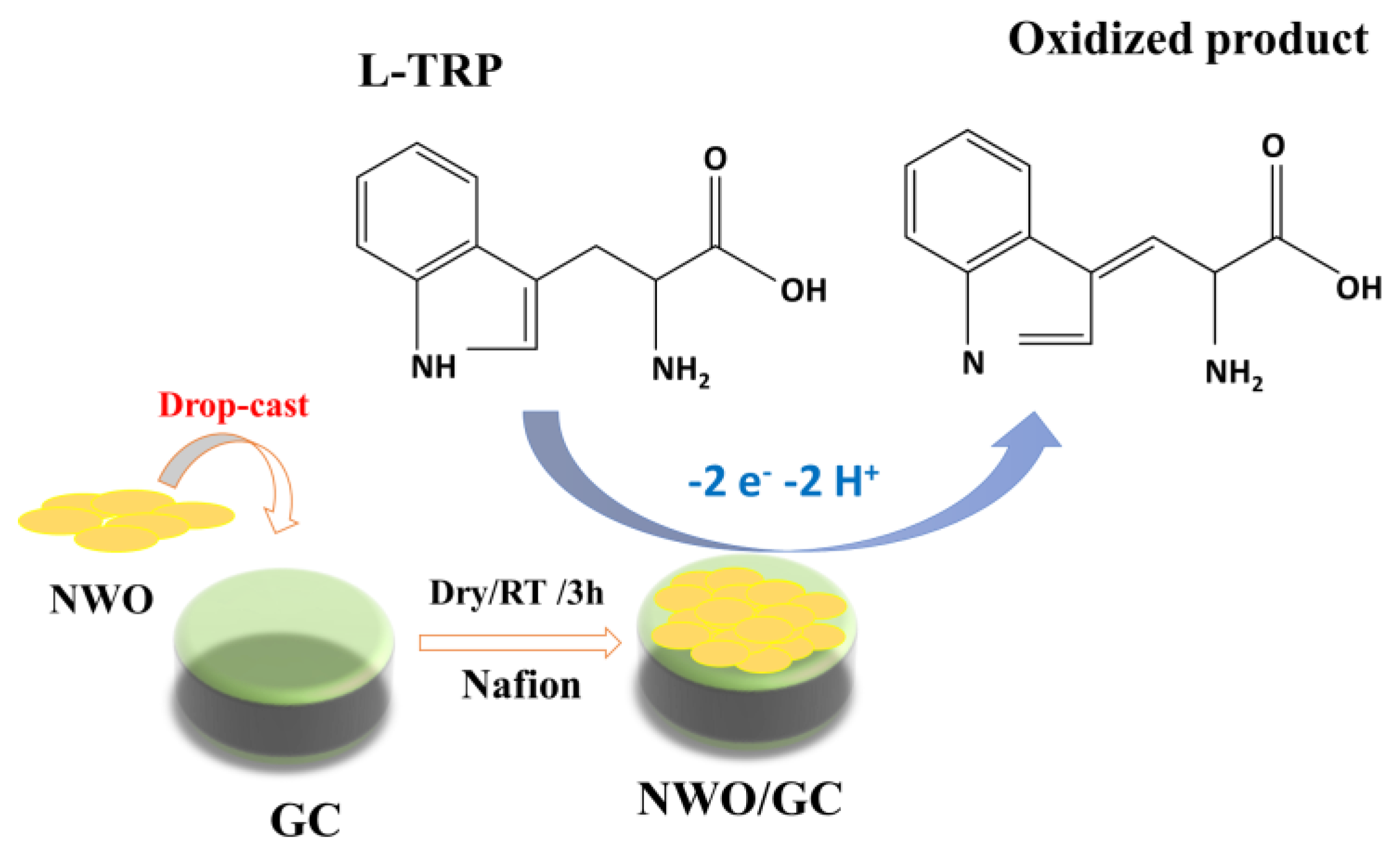

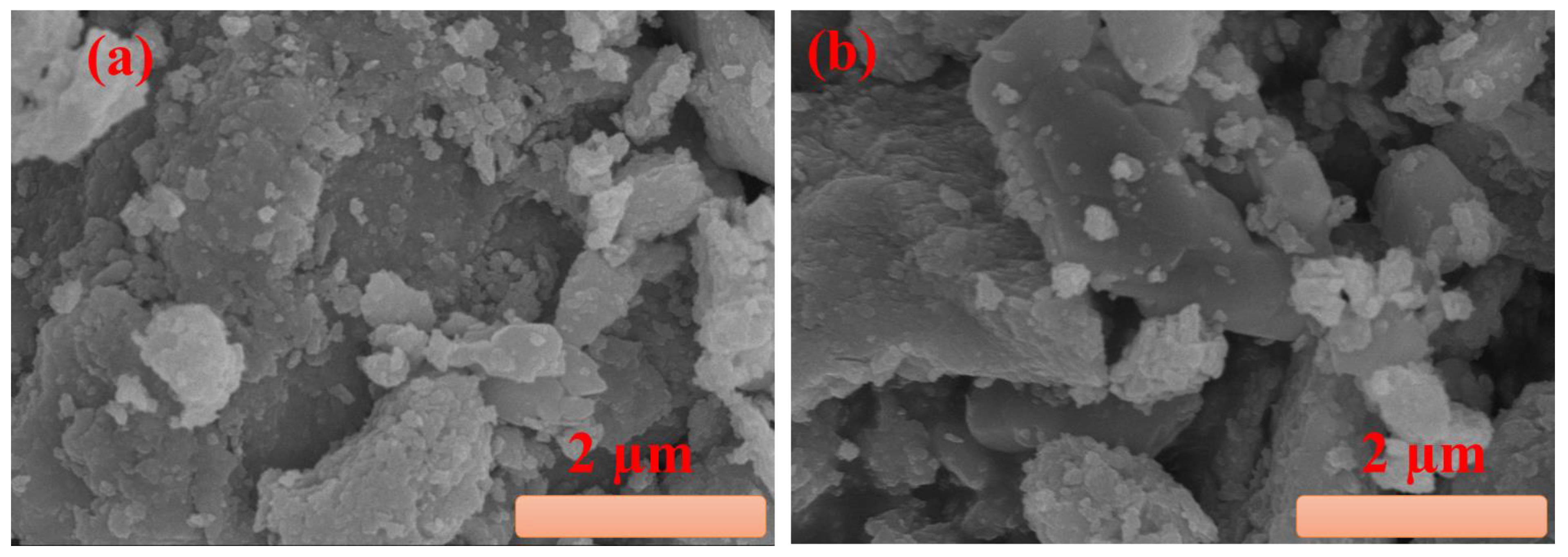
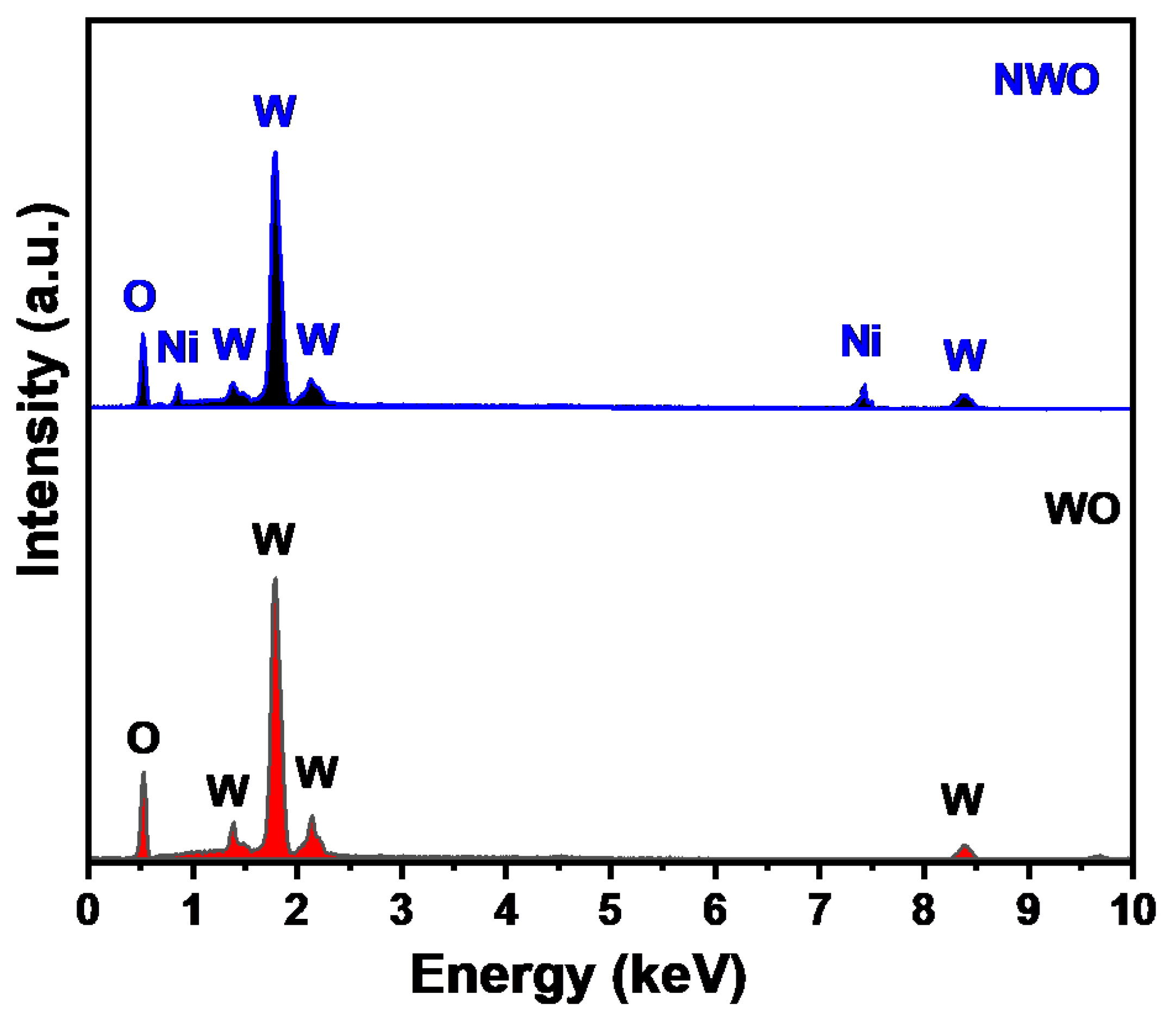

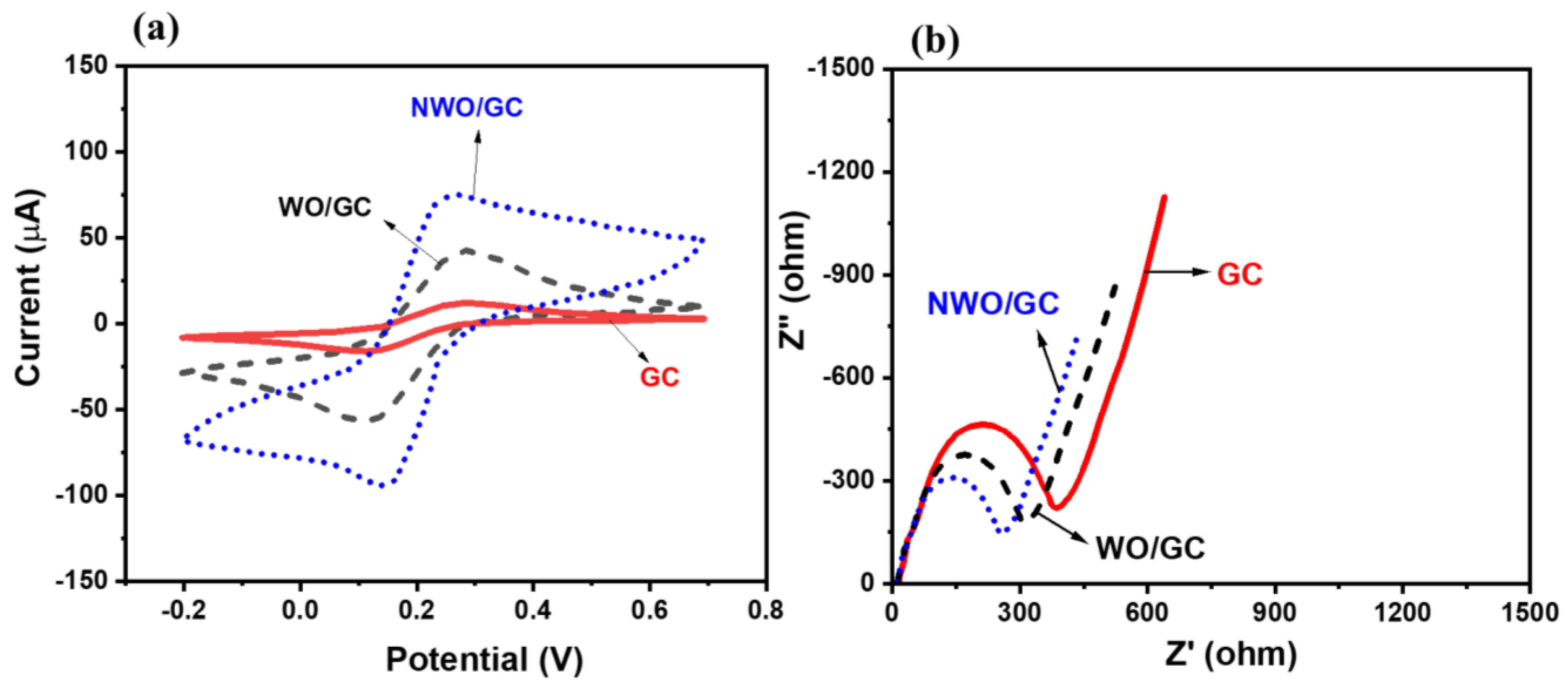
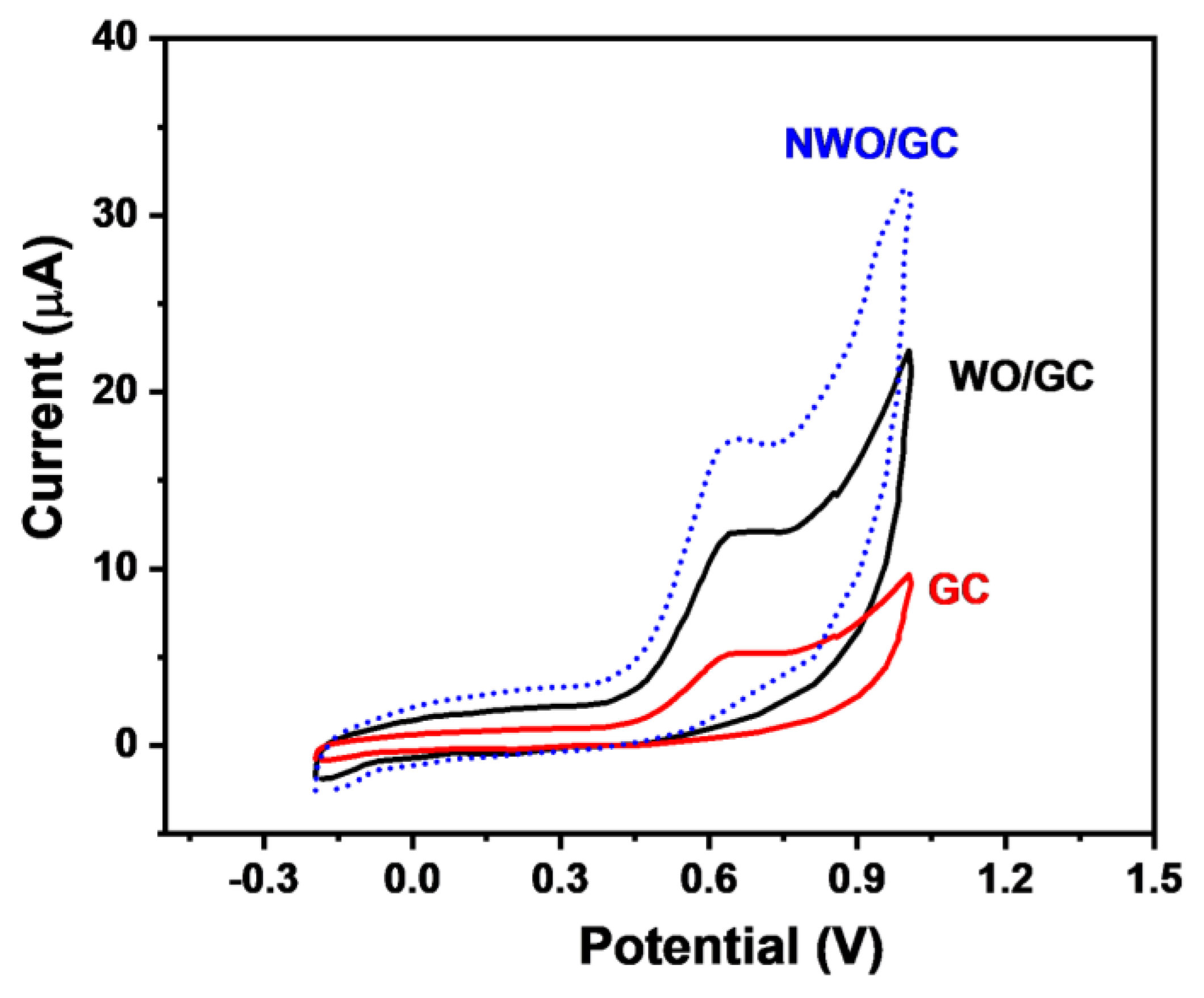
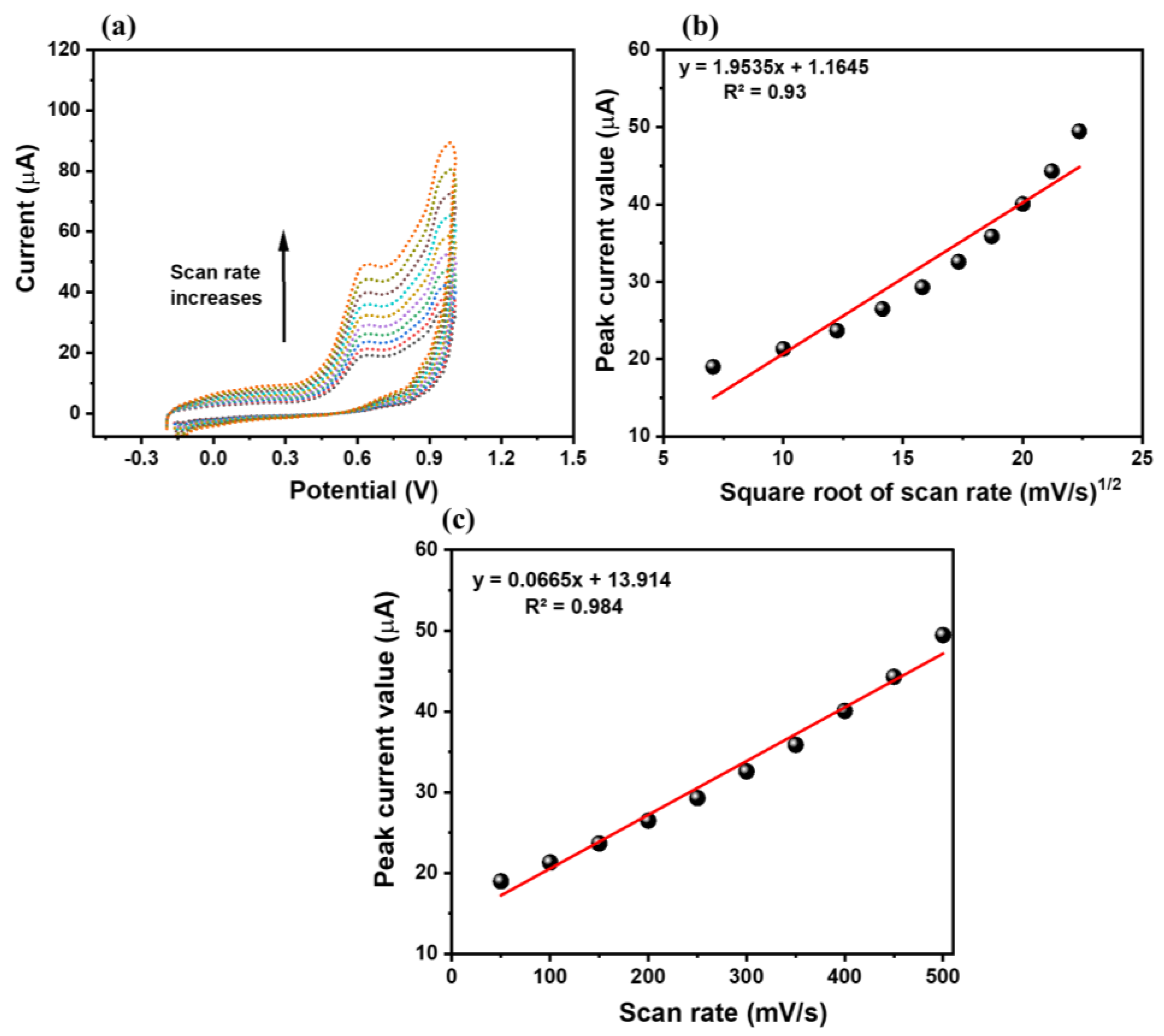
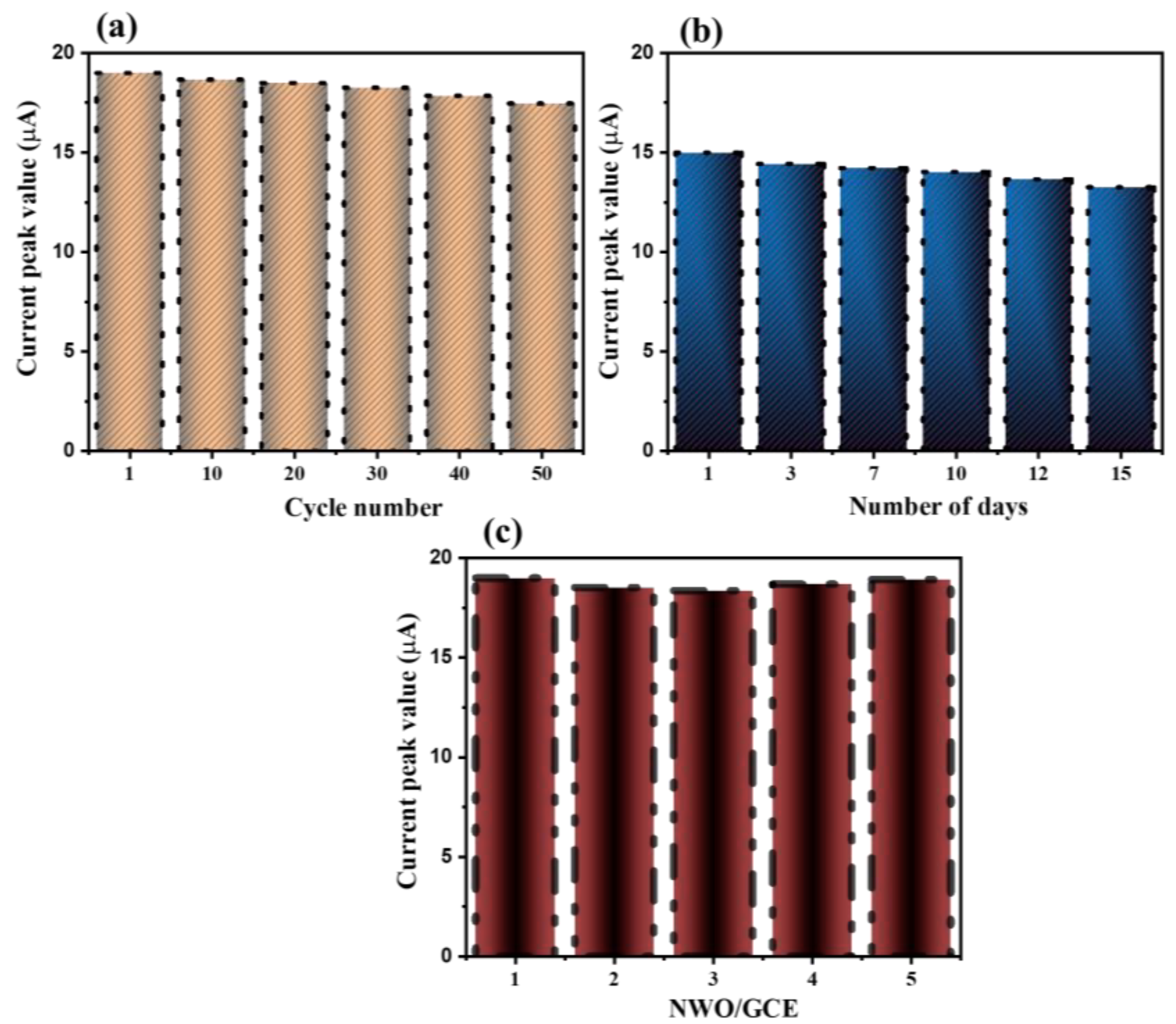
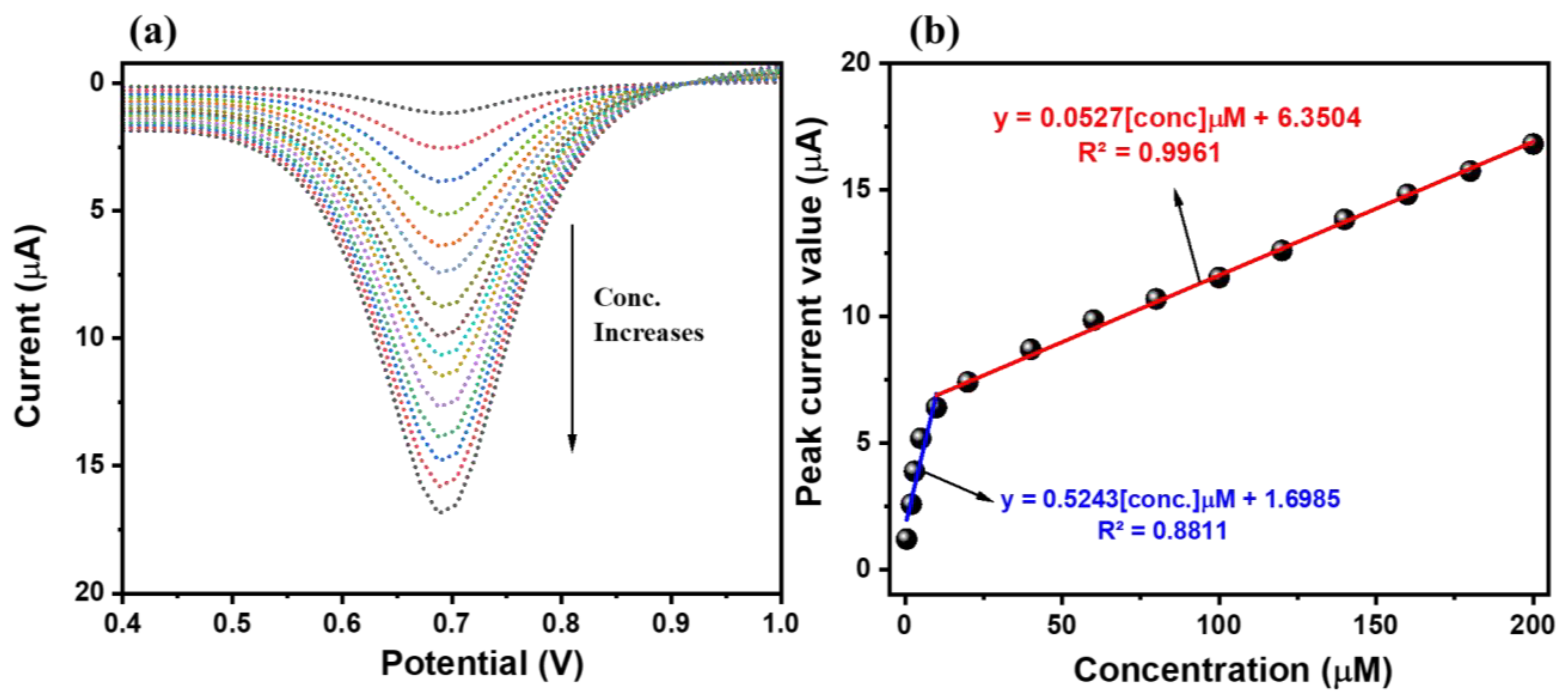
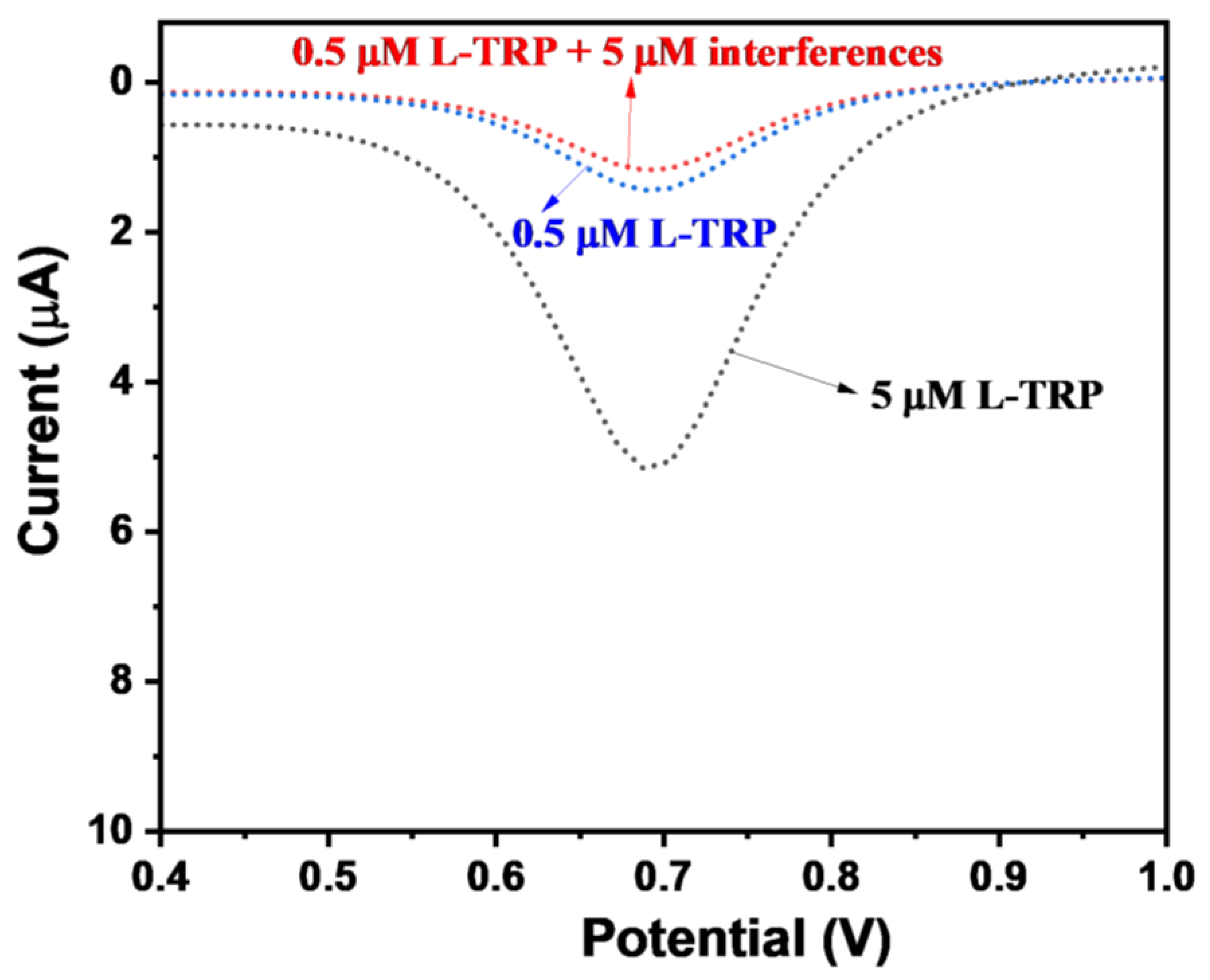
| Catalyst | LOD (µM) | Linear Range (µM) | References |
|---|---|---|---|
| NWO/GC | 0.1 | 0.5–10, 10–200 | This study |
| NiO/CNT/PEDOT/GCE | 0.21 | 1–41 | 18 |
| β-CD/CQDs/GCE | 0.16 | 5–270 | 7 |
| Ni-ZIF-8/N S-CNTs/CS/GCE | 0.69 | 5–850 | 36 |
| QDs/SiO2-MIP | 0.35 | 0–8 | 37 |
| Au-MWCNTs | 3 | - | 38 |
Disclaimer/Publisher’s Note: The statements, opinions and data contained in all publications are solely those of the individual author(s) and contributor(s) and not of MDPI and/or the editor(s). MDPI and/or the editor(s) disclaim responsibility for any injury to people or property resulting from any ideas, methods, instructions or products referred to in the content. |
© 2024 by the authors. Licensee MDPI, Basel, Switzerland. This article is an open access article distributed under the terms and conditions of the Creative Commons Attribution (CC BY) license (https://creativecommons.org/licenses/by/4.0/).
Share and Cite
Khan, M.Q.; Ahmad, K.; Khan, R.A. Design and Fabrication of Tryptophan Sensor Using Voltammetric Method. Micromachines 2024, 15, 1047. https://doi.org/10.3390/mi15081047
Khan MQ, Ahmad K, Khan RA. Design and Fabrication of Tryptophan Sensor Using Voltammetric Method. Micromachines. 2024; 15(8):1047. https://doi.org/10.3390/mi15081047
Chicago/Turabian StyleKhan, Mohd Quasim, Khursheed Ahmad, and Rais Ahmad Khan. 2024. "Design and Fabrication of Tryptophan Sensor Using Voltammetric Method" Micromachines 15, no. 8: 1047. https://doi.org/10.3390/mi15081047





